

Alphabet books offer a vivid insight into the history of literacy and culture, as well as concepts of childhood. The Children's Book Collection at UCLA contains a rich array of these materials, some well-worn and much-used, some still bright and fresh. Each is a gem of print production and graphical imagery from another time and place. Though the history of alphabet books continues to the present, this exhibit focuses on the works in our collections published between 1700 and 1900, including horn books, primers, works of didacticism and seriousness, whimsy and play.
2. A Jumble ABC
3. A Little Pretty Pocket-Book
4. A New Lottery Book of Birds And Beasts
5. A Pretty Play-Thing for Children of All Denominations
8. ABC of Objects for Home And School
10. ABC with Pictures & Verses
12. Alphabet Et Instruction Pour Les Enfans
16. Dolly's ABC Book
17. Flora's ABC
18. Home ABC
22. Hornbook C. 1700
23. Large Letters for the Little Ones
24. Little ABC Book
25. Little People: An Alphabet
26. Martin's Nursery Battledoor
27. Mother Goose ABC
28. My Darling's ABC
29. Orbis Sensualium Pictus Quadrilinguis
30. People of All Nations: A Useful Toy for Girl Or Boy
31. Picture Alphabet
32. Pretty ABC
33. Railway ABC
34. Rusher's Reading Made Most Easy
38. The Alphabet of Old Friends
40. The Amusing Alphabet for Young Children Beginning To Read
42. The Child's Christian Education
45. The Easter Gift
47. The Favorite Alphabet for the Nursery
49. The Franklin Alphabet And Primer
51. The Golden ABC
55. The Moral And Entertaining Alphabet
57. The Old Testament Alphabet
59. The Picture Alphabet for Little Children
62. The Sunday ABC
63. The Union ABC
64. The Young Child's ABC, Or, First Book
65. Tom Thumb's Alphabet: Picture Baby-Books
67. Warne's Alphabet And Word Book: with Coloured Pictures
68. Wood's Royal Nursery Alphabet
Title The American Primer
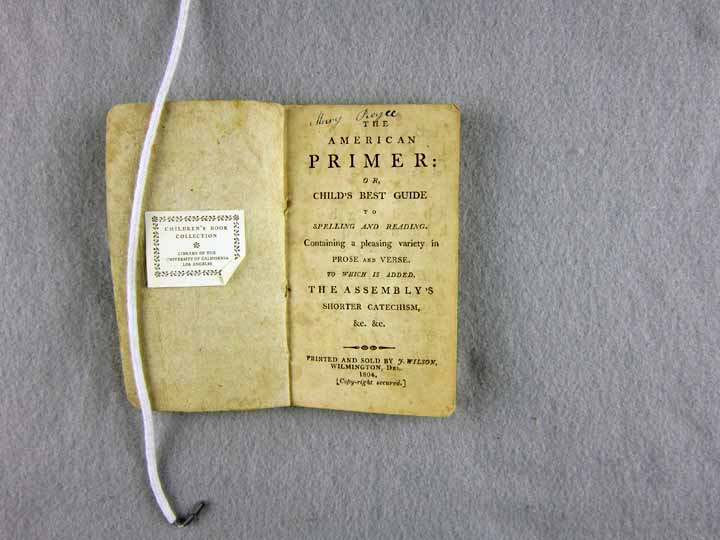
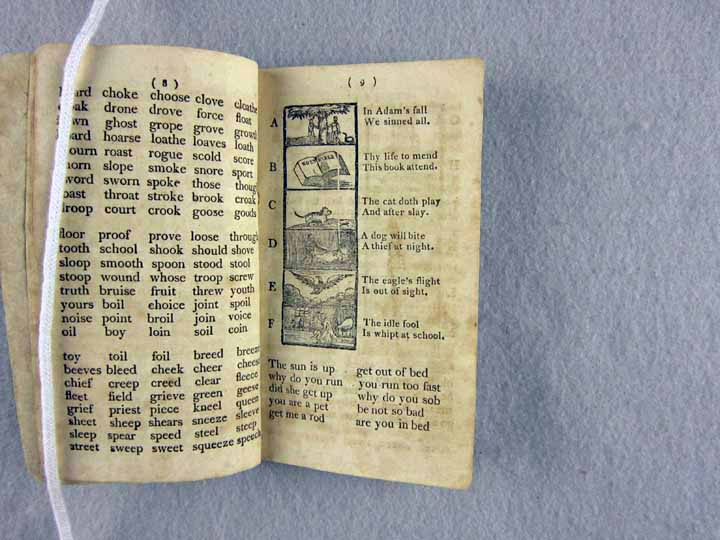
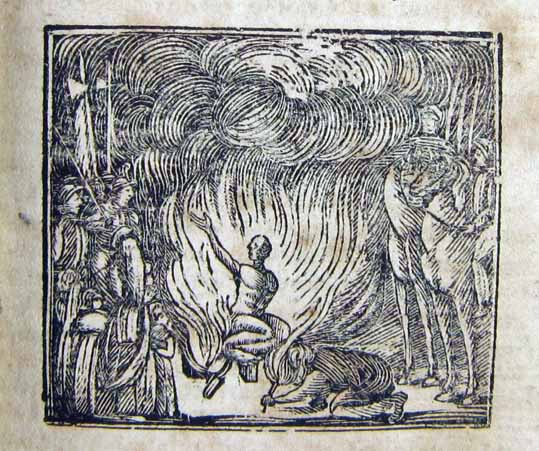
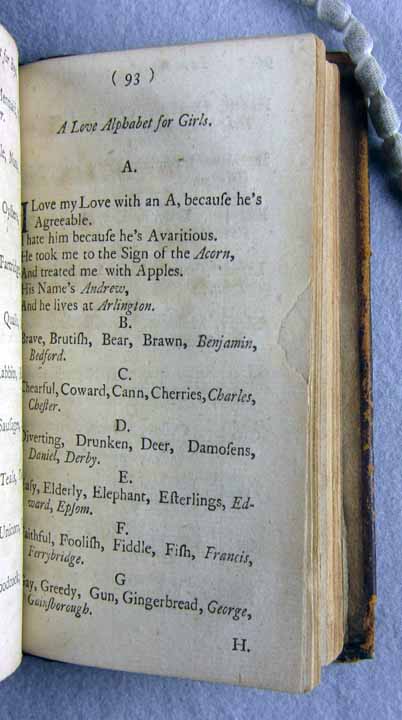
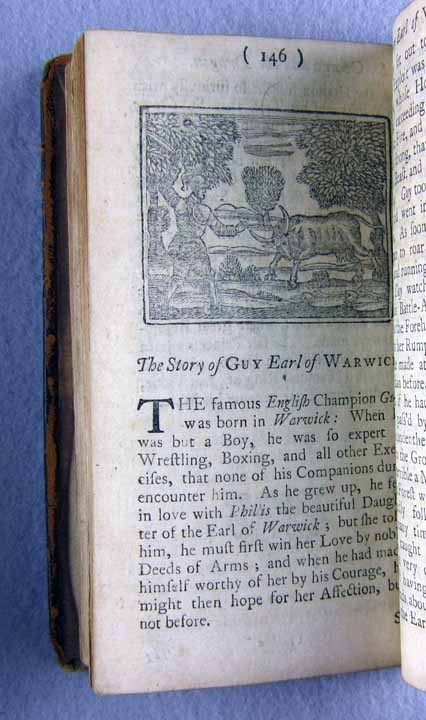
Brief description Paper binding. 72 pages.
Full description The American Primer, or, Child's best guide to spelling and reading, containing a pleasing variety in prose and verse: to which is added, the Assembly's shorter catechism &c. &c. It was published in 1804 in Wilmington, Delaware.
It is a primer meant to teach children how to read as well as be good Christians. It includes lists of words of various lengths, hymns, poems, catechisms, creeds, the Ten Commandments, and stories. It was printed and sold by J. Wilson. The 14 cm tall book is in a paper binding, 72 pages long, and contains woodcut illustrations.
Literacy The main preoccupation of the Puritans was salvation, and they believed that all humans were naturally sinful and needed to be saved from destruction, even infants and children. In order to be saved, people needed to read the Bible, recognize their need for salvation, and repent of their sins. Children had to learn to read as soon as possible because of their naturally sinful souls. This belief in sinful humanity made literacy a top priority, because the Bible was the foundation and handbook of Christianity.
Literacy and religion were tied up together; in order to be religious, one needed to read, so being literate was practically a religious act. Literacy and the Bible are given equal billing in The American Primer. The Primer's famous alphabet rhyme starts with "In Adam's fall/We sinned all" for the letter A and continues with "Thy life to mend/This book attend," for the letter B, thus making reading a vital act.
The Ten Commandments are repeated three times in three different formats: copied directly from the Bible, in verse, and in a positive way that does not use "shall not" in each commandment. Most of the Primer is given over to serious moral instruction: children are to put God first, then the king, then their parents. At least one catechism is included; the short questions and answers are meant to teach children the tenets of Christianity.
Sections that are meant to teach children literacy include a syllabary and groups of words and sentences of increasing difficulty. The Primer also contains didactic hymns and poems, which were included presumably because things written in verse are easier to remember and learn, especially for young children.
Childhood The American Primer was printed in 1804, but the manner and thinking reflect the colonial period's view of the need to mold children into good Christians.The American Primer resoundingly echoes and embraces the Protestant notion of children, which held that as human beings, children were naturally sinful and needed to be trained to be obedient, hardworking, and productive members of society.
Young deaths were common (there is even a poem about this in the Primer), and because child baptism was not practiced in Protestantism, children needed to be made aware of their sin and need for salvation as early as possible. There is a sense of urgency throughout The American Primer: children must learn the right things, children must be good, children must be saved, because life is short and hell is terrible.
The Primer is very didactic religiously as well as educationally. It contains hymns and stories with morals, such as one about good and bad boys and girls and their consequent fates. A dialogue between a Youth, Christ, and the Devil ends with the Youth going to hell because he rejected Christ. Children were shaped into proper Christians with every tool necessary, including fear. Childhood was seen as preparation for adulthood, so it was vital that children learn correct behaviors and the beliefs of Christianity. The message of The American Primer can be summarized in five words: be good and be saved.
Iconography The American Primer is a text-heavy book that contains a few woodcut illustrations. Woodcut illustrations are made by carving the mirror image of a picture into a block of wood in order to create a stamp. The parts the printer wants to have print remain, while the wood that is not part of the image is carved away to leave white space. This method of production results in images that are somewhat crude but still detailed.
The woodcuts accompanying the alphabet letters display the main item or concept given in the rhyme. The letter A's illustration for "In Adam's fall/We sinned all" shows Adam and Eve on either side of a tree with a snake in it. The letter B's "Thy life to mend/This book attend" shows an open book with "HOLY BIBLE" written on its pages. The other letters' illustrations depict Bible characters and stories, animals, and short moral stories (the illustration for the letter F's rhyme, "The idle fool/Is whipt at school," shows just that).
The letters, their rhymes and their illustrations are six to a page; the illustrations for each letter were most likely all carved on a single wood block. Other than the alphabet rhymes, there are few illustrations. One is a two-inch-square woodcut depicting the martyrdom of John Rogers. The man is being burned at the stake while his wife and nine children (one in its mother's arms) watch. Overall, the Primer is short on pictures and long on words.
Production The American Primer, or, Child's best guide to spelling and reading: containing a pleasing variety in prose and verse: to which is added, the Assembly's shorter catechism &c. &c. was published in 1804 in Wilmington, Delaware. It was printed and sold by J. Wilson; the 14 cm tall book is in a paper binding, 72 pages long, and contains woodcut illustrations. The small book would have been easy for the child to hold or slip into a pocket.
The American Primer has many similarities to The New England Primer, which was published at the beginning of America's colonization in the late 1600s. The famous alphabet rhyme that begins with, "In Adam's fall/We sinned all," has different rhymes for most of the other letters, however. The American Primer's contents are essentially the same as its predecessor's (the religiously didactic texts, woodcut illustrations of martyrs and Biblical figures, the urgent need to save children's souls), but the name change reflects the United States of America's establishment as an independent country.
Thus the Primer's publication shows a fascinating contrast: when it was published the book had been used for over a hundred years to teach pilgrim children to read, indicating a nostalgic look back to the early years of the New World, yet the name change indicates turning one's face to the future. The old was given a new name.
The Puritans did not have a concept of publishing for children specifically, apart from procuring educational and religious print materials from which to teach their children to read. However, books for children were an important part of a publishing business. Educational materials and storybooks were a steady source of income for publishers in this era, who could be certain they would sell well.
The production of American children's books increased after the country gained its independence, but most books were reprints of English books. The Primer continued to be printed and used through the nineteenth century, even as children's books began to veer away from strident religious teachings and towards a more gentle morality.
Publisher J. Wilson
Publication place Wilmington
Date 1804
UCLA Call Number CBC PE1119.A1 A445 1804
Repository UCLA Charles E. Young Research Library, Dept. of Special Collections
Dimensions 14 cm, height
Technologies of production Letterpress printing, woodcut (process)
Caption